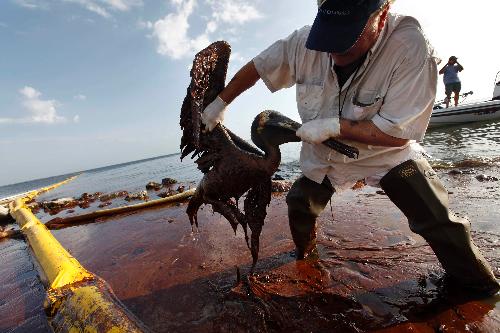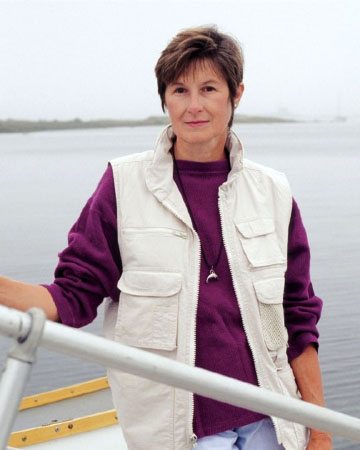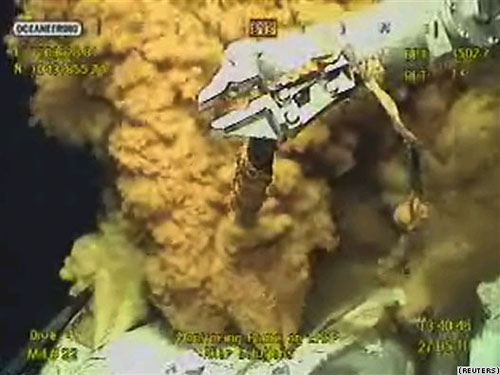
Plaquemines Parish coastal zone director P.J. Hahn lifts an oil-covered pelican near some ocean boom off the Gulf of Mexico. Canada is sending half its national stock of ocean boom to the gulf to help contain the massive oil spill. Associated Press photo.
By Stephen Lendman
June 11, 2010
As more information surfaces, a potentially biblical disaster is unfolding, threatening to make vast parts of the Gulf dead zones, animals and plant species so contaminated and unsafe that Gulf communities may face “the total end of fishing,” according to Carl Safina, Blue Water Institute ocean biologist.
“I don’t see how the fish populations will be able to withstand what has happened. The basis of their livelihoods is being destroyed. This is not a temporary issue. Those things don’t come back the day the oil stops,” and no end of it so far is in sight.

Carl Safina, PhD is the president and co-founder of the Blue Ocean Institute, which uses science, art and education to inspire conservation of the seas. Photo courtesy of Blue Ocean Institute
On May 30, the UK Independent’s Emily Dugan headlined “Oil spill creates huge undersea dead zones,” according to oceanologists and toxicologists, saying:
If experts are right, “the sea’s entire food chain could suffer years of devastation, with almost no marine life in the region escaping its effects.”
Many scientists believe what’s unseen below the surface will have the deadliest impact because of the combination noxious oil and toxic dispersants, combined to make a growing disaster far worse.
Over 8,300 animal and plant species are at risk. Some may face extinction, but the true toll won’t be known for years.
“In previous spills, oil rose to the surface and was dealt with there,” but hundreds of thousands of gallons of dispersants used has kept much of the it submerged, “resulting in unprecedented underwater damage to organisms in the Gulf.”
Once toxins enter the food chain, none of it escapes harm, and some may be lost forever, the result of what Marine Environmental Research Institute director Susan Shaw calls “the biggest environmental disaster of our time,” saying:
She’s been diving in damaged areas and “is horrified by the contamination caused by BP’s continued use of dispersants. They’ve been used at such a high volume that it’s unprecedented. The worst of these – Corexit 9527 – is the one (most used. It) ruptures red blood cells and causes fish to bleed.” With so much in the water over large areas, “we can only imagine the death that will be caused.”
Shaw explained that contaminated plankton and smaller shrimps will be eaten by larger fish, passing the deadly mix up the food chain, “dismantling (it), piece by piece.”

Dr. Susan Shaw, founder and director of MERI.
On June 8, University of South Florida’s College of Marine Science “confirmed the (large widespread) presence of distinct layers of degraded oil (in two deep water plumes) of the northern Gulf of Mexico many miles from the Deepwater Horizon explosion site” – based on research it conducted and continues to pursue. In late May, its scientists reported one plume 22 miles long and 100 feet thick.
One or more others now exist and continue getting larger. BP denies they exist, CEO Tony Hayward saying “The oil is on the surface. They’re aren’t any plumes.”
According to Harte Research Institute for the Gulf of Mexico Studies director, Larry McKinney, “At the depth that these plumes are at, (vast parts of) the sea will be toxic for God knows how long.”
Tulane University’s Ecology and Evolutionary Biology department Professor, Michael Blum, warns about mass extinction, saying:
“There are….hundreds of shorebirds and marine mammals that are acutely sensitive to oil. You could potentially lose whole species, have extinction events.” Other experts share that view about a disaster so huge, it’s hard imagining how bad it may get. Some fear the worst – yet the administration, BP and most major media reports conceal it, though gradually more information comes out.
It Gets Worse
Complicit with BP from day one, Obama’s Interior Department falsified results of a National Incident Command Flow Rate Technical Group estimate of the oil leaking at from 12,000 – 19,000 barrels daily – its low figure, not the true volume its scientists feel is “significantly higher.”
Indeed so believes University of California, Santa Barbara, Professor Ira Leifer, a noted expert at estimating flow rates, saying satellite data he’s examined shows it’s been increasing over time, especially after BP’s “top kill” method failed. Then severing the damaged riser pipe to install a “top hat” increased the rate far more than BP’s 20 percent estimate.
At worst, he thinks as much as 100,000 barrels daily are leaking, based on new video images showing the flow of black oil is unimpeded. He also said “BP is playing games with us, presumably under the advice of their legal team.”

A video grab shows a robotic arm using a wrench during the "top kill" procedure aimed at stopping the flow of oil from BP's "Deepwater Horizon" oil well on May 27.
Indeed so according to a May 26 Reuters report citing a US Clean Water Act clause, added in 1990 after the Exxon Valdez disaster. Unlike BP’s $75 million liability cap for economic damages, Washington can assess fines of up to $4,300 for every barrel spilled.
The basic fine is $1,100 per barrel. However, if courts rule gross negligence, much more perhaps is likely. In the past, civil fines were a modest percent of total cost, but given the size of this disaster and its unprecedented damage and outrage, stiffer penalties may result.
Given the best of reliable estimates, University of Michigan’s Environmental Law program director, Professor David Uhlmann, believes:
“These civil penalties could be staggeringly high, possibly running into the billions, (maybe) tens of billions,” including clean-up costs, economic damages, compensatory and punitive ones, and possible criminal liability.
A late April Bernstein Research estimate put BP’s liability up to $8 billion, but the figure excluded possible penalties, and didn’t consider a catastrophe this great or its likely duration – combined, having the potential to bankrupt the company and very likely get its CEO Tony Hayward fired, considered damaged goods, perhaps with other tainted officials sharing responsibility for the cost, major PR disaster, and criminal negligence, even the best PR and containment can’t conceal.
Initially, BP and the Obama administration said 1,000 daily barrels, then 5,000, and now 12,000 – 19,000, much of which is being recovered according Coast Guard Admiral Thad Allen, repeating what BP tells him, and even now can’t admit the obvious about plumes.
Early amounts captured combined oil and sea water, likely as true now despite announced company claims that always are bogus and can’t be believed.
Repeatedly up to now, Harward and other BP officials lied, suppressed the truth, and continue to control everything, including clean-up efforts. At best, they’ve done little, provided bare-bones financial compensation, and no other help to affected residents – the Obama administration letting them operate secretly and negligently, in spite of continued bungling, obstruction, and criminal negligence or worse.
A Potential Doomsday Scenario
According to University of Georgia biogeochemist, Samantha Joye, the vast underwater plumes are “unlike anything else that has ever been seen anywhere, certainly in human history, (and they) threaten to wreak havoc on marine life. (Also unprecedented are) extremely high levels of methane. It’s impossible to know what (its) impacts” will be, something that will take years to understand. Besides the enormous damage to the Gulf, Joye’s greatest fear is one or more hurricanes, pushing the oil ashore, and spreading it through torrential rains well inland, and contaminating vast crops and farmland over a vast area.
On June 8, oil expert Matthew Simmons, on MSNBC’s Dylan Ratigan show, said the enormity of the Gulf disaster has been grossly underestimated. He believes from 100,000 – 150,000 barrels are spewing out daily, mostly from “an open hole with no casing in it which sits about seven miles away from where BP has ben trying to fix these little tiny leaks in the drilling riser.”
After the explosion, 40,000 – 50,000 pounds of pressure per square inch intensified the fire and popped the blowout preventer like a cork. Then the casing came out, so “we have an open hole that’s spewing I would guess somewhere between 100 – 150,000 barrels a day of oil which is why you now have over a 100 mile oil lake at the bottom of the Gulf….that’s apparently 4 – 5,000 feet deep.”
“I think (we’ll) discover that we have an open hole with no casing in it,” so to contain the leak, BP is doing “everything wrong. (They are) trying to patch a little leak in the drilling riser” when the real problem is an open hole with no casing in it. If true, as is likely, “the only way we’ll shut it off is either let it (exhaust itself over up to) 30 years….or put a nuclear device down the hole,” blow it up, and encase it in melted rock (a “glassy plug”) – but not without the enormous risk of irradiating the Gulf and all plant and animal species in it.
According to New York University Physics Professor Michio Kaku, sealing the Gulf leak(s) with a nuclear device amounts to a “huge science experiment, with unintended consequences,” including potentially:
— releasing “dangerous, water-soluble chemicals such as radioactive iodine, strontium, and cesium, which would contaminate the food chain in the Gulf;
— the ‘seal’ created by the glassified sand is probably unstable; (and)
— it might actually make the problem worse, creating many mini leaks on the ocean floor.”
Further, eight or more hurricanes are predicted. If one or more hit the Gulf, “it means that seawater several hundred feet below the surface of the water could be churned up and then deposited over the South. This seawater, containing oils and radioactive fission products, would magnify the environmental problem” hugely. As a result, Kaku strongly opposes the nuclear option, given the enormous risks and no way to contain them.
Final Comments
Obama isn’t letting the Gulf disaster slow his offshore drilling support. After the April 20 explosion, the Interior Department’s Minerals Management Service (MMS) approved 27 more projects, 26 exempted from environmental review, including two for BP getting the Center for Biological Diversity’s Executive Director, Kieran Suckling to say:
“The MMS has learned absolutely nothing from this national catastrophe. It is still illegally exempting dangerous offshore drilling projects in the Gulf of Mexico from all environmental review. It is outrageous and unacceptable.”
Then on June 7, the Obama administration announced new safety guidelines ahead (more cosmetic than with teeth) to expedite dozens of shallow water operations, besides more deep water ones once his appointed commission completes its disaster investigation, sure to produce distortion, obstruction and whitewash.-
He’s also promoting the outlandish cap and trade legislation (through the House, not the Senate) – promoted as a climate/clean energy bill that, in fact, will raise energy prices and enrich Wall Street through a new carbon trading scam, greater than the housing and derivatives ones combined.
With an administration and Congress supporting monied and power interests, most Americans are on their own and out of luck economically, politically, and environmentally, besides their safety, security and well-being, not important under either party in charge, so it’s for grassroots activism to bring change.
Stephen Lendman is a Research Associate of the Centre for Research on Globalization. He lives in Chicago and can be reached at lendmanstephen@sbcglobal.net. Also visit his blog site at sjlendman.blogspot.com and listen to The Global Research News Hour on RepublicBroadcasting.org Monday through Friday at 10am US Central time for cutting-edge discussions with distinguished guests on world and national topics. All programs are archived for easy listening.


 The Hunger Site
The Hunger Site
June 12, 2010 at 4:48 pm
…and now, almost by magic, this:
Breaking news: Pipeline leak spills 400+ barrels of oil into Salt Lake City waterways, coating scores of birds in black.
and really, nothing new…
if i weren’t going out of town for 3 months, i’d be joining up with these folks:
http://www.spiritualprogressives.org/article.php/20100427162647109
June 12, 2010 at 11:43 am
actually, i think we (the people) are both the apprentice and the master…but this bp episode challenges us to become the master, and to fiercely protect the sustainability of our world—in all realms.
June 12, 2010 at 11:28 am
i don’t think you’re diminishing the horror, ann, i think you are putting it in its proper perspective…
i just made a comment to this story from mother jones:
http://motherjones.com/rights-stuff/2010/06/grande-terre-dolphin-towels-bp-cleanup
suggesting that a story i’d like to see is to put a spotlight on how many “spills” there have been, all over the world, for the last 20-30 years…
it is one of the reasons i got to baker beach back in ’06 here in sf, despite the yellow tape, and for my efforts got to voice my dismay/disgust at the regularity of oil spills on npr, “all things considered”.
well, of course, it is amply clear that my voice was a voice in the wilderness, gone unheeded.
but now, the level of this catastrophe demands nothing less than unified action….and if the president himself won’t make a speech touching on how we all need to change in order to be a sustainable society, then it is we the people that need to demand it.
for any of you who remember “The Sorcerer’s Apprentice” (a Disney classic from the 1940 film Fantasia), this crisis reminds me exactly of the premise in the film. Go rent it, and be amazed…for a synopsis go here:
http://en.wikipedia.org/wiki/Fantasia_(film)#The_Sorcerer.27s_Apprentice
and thinking about that, we the people are in the position of the Master, who indeed should be quite angry at BP and others for not having the proper “knowing” to do what it has been doing, and in the process jeopardizing our natural world…I know that this crisis is an opportunity-in-the-making…it has to be. We’re only in the beginning stages…
June 11, 2010 at 2:00 pm
I don’t mean to diminish the horror, but a London Guardian environmental reporter says that, in Nigeria, “more oil is spilled from the [Niger] delta’s network of terminals, pipes, pumping stations and oil platforms every year than has been lost in the Gulf of Mexico . . . by the explosion that wrecked BP’s Deepwater Horizon rig last month. http://goo.gl/kj9V